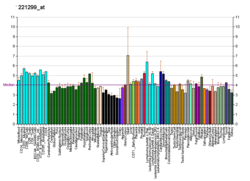Top Qs
Timeline
Chat
Perspective
GPR173
Protein-coding gene in humans From Wikipedia, the free encyclopedia
Remove ads
Probable G-protein coupled receptor 173 is a protein that in humans is encoded by the GPR173 gene.[5][6]
Remove ads
Function
Summarize
Perspective
GPR173 is a highly conserved G protein-coupled receptor (GPCR) that plays a significant role in the regulation of the hypothalamic-pituitary-gonadal (HPG) axis, which is central to reproductive function.[7][8][9] It is expressed in the brain and ovaries, where it is considered the putative receptor for the peptide hormone phoenixin (PNX).
Activation of GPR173 by phoenixin potentiates the secretion of luteinizing hormone (LH) in response to gonadotropin-releasing hormone (GnRH), thereby promoting ovarian cycling and supporting reproductive processes.[8][9] Beyond reproduction, GPR173 has been implicated in diverse physiological functions such as food intake regulation, learning and memory, anxiety, inflammatory responses, and cardiac protection, largely through its modulation by phoenixin.[9]
Additionally, GPR173 may act as a receptor for cholecystokinin (CCK) in certain brain regions, mediating inhibitory synaptic plasticity and potentially serving as a therapeutic target for disorders involving excitation-inhibition imbalance.[10] The expression of GPR173 can be influenced by nutritional and environmental factors, indicating its role as a sensor and mediator in integrating external signals with neuroendocrine pathways.[7]
Remove ads
Ligands
Recent studies have found GPR173 may act as the receptor for the peptides phoenixin-14 (PNX-14) and phoenixin-20 (PNX-20).[11][12][8] Both Phoenixins are alternate cleavage products of SMIM20.[11]
See also
References
Wikiwand - on
Seamless Wikipedia browsing. On steroids.
Remove ads





